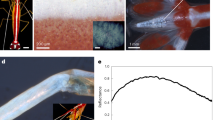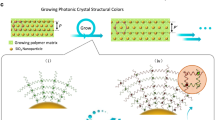Abstract
Spectacular natural optical phenomena are produced by highly reflective assemblies of organic crystals. Here we show how the tapetum reflector in a shrimp eye is constructed from arrays of spherical isoxanthopterin nanoparticles and relate the particle properties to their optical function. The nanoparticles are composed of single-crystal isoxanthopterin nanoplates arranged in concentric lamellae around a hollow core. The spherulitic birefringence of the nanoparticles, which originates from the radial alignment of the plates, results in a significant enhancement of the back-scattering. This enables the organism to maximize the reflectivity of the ultrathin tapetum, which functions to increase the eye’s sensitivity and preserve visual acuity. The particle size, core/shell ratio and packing are also controlled to optimize the intensity and spectral properties of the tapetum back-scattering. This system offers inspiration for the design of photonic crystals constructed from spherically symmetric birefringent particles for use in ultrathin reflectors and as non-iridescent pigments.
This is a preview of subscription content, access via your institution
Access options
Access Nature and 54 other Nature Portfolio journals
Get Nature+, our best-value online-access subscription
$29.99 / 30 days
cancel any time
Subscribe to this journal
Receive 12 print issues and online access
$259.00 per year
only $21.58 per issue
Buy this article
- Purchase on Springer Link
- Instant access to full article PDF
Prices may be subject to local taxes which are calculated during checkout






Similar content being viewed by others
Data availability
The data that support the findings of this study are available from the corresponding authors upon reasonable request.
References
Kinoshita, S., Yoshioka, S. & Miyazaki, J. The physics of structural colors. Rep. Prog. Phys.71, 2–30 (2008).
Parker, A. R. 515 million years of structural colour. J. Opt. A2, R15 (2000).
Vukusic, P. & Sambles, J. R. Photonic structures in biology. Nature424, 852–855 (2003).
Ling, L. et al. A highly conspicuous mineralized composite photonic architecture in the translucent shell of the blue-rayed limpet. Nat. Commun.6, 6322 (2015).
Noh, H. et al. How noniridescent colors are generated by quasi-ordered structures of bird feathers. Adv. Mater.22, 2871–2880 (2010).
Vukusic, P., Hallam, B. & Noyles, J. Brilliant whiteness in ultrathin beetle scales. Science315, 348 (2007).
Vignolini, S. et al. Pointillist structural color in Pollia fruit. Proc. Natl Acad. Sci. USA109, 15712–15715 (2012).
Harun-Ur-Rashid, M. et al. Angle-independent structural color in colloidal amorphous arrays. ChemPhysChem11, 579–583 (2010).
Forster, J. D. et al. Biomimetic isotropic nanostructures for structural coloration. Adv. Mater.22, 2939–2944 (2010).
Saranathan, V. et al. Structure and optical function of amorphous photonic nanostructures from avian feather barbs: a comparative small angle X-ray scattering (SAXS) analysis of 230 bird species. J. R. Soc. Interface9, 2563–2580 (2012).
Burresi, M. et al. Bright-white beetle scales optimise multiple scattering of light. Sci. Rep.4, 6075 (2014).
Mäthger, L. M. et al. Bright white scattering from protein spheres in color changing, flexible cuttlefish skin. Adv. Func. Mater.23, 3980–3989 (2013).
Denton, E. J. & Land, M. F. Mechanism of reflexion in silvery layers of fish and cephalopods. Proc. R. Soc. Lond. B178, 43–61 (1971).
Gur, D., Palmer, B. A., Weiner, S. & Addadi, L. Light manipulation by guanine crystals in organisms: biogenic scatterers, mirrors, multilayer reflectors and photonic crystals. Adv. Func. Mater.27, 1603514 (2017).
Jordan, T. M., Partridge, J. C. & Roberts, N. W. Non-polarizing broadband multilayer reflectors in fish. Nat. Photon.6, 759–763 (2012).
Gur, D. et al. The mechanism of color change in the neon tetra fish: a light-induced tunable photonic crystal array. Angew. Chem. Int. Ed.54, 12426–12430 (2015).
Gur, D. et al. Structural basis for the brilliant colors of the Sapphirinid copepods. J. Am. Chem. Soc.137, 8408–8411 (2015).
Teyssier, J., Saenko, S. V., van der Marel, D. & Milinkovitch, M. C. Photonic crystals cause active colour change in chameleons. Nat. Commun.6, 6368–6375 (2015).
Palmer, B. A. et al. The image-forming mirror in the eye of the scallop. Science358, 1172–1175 (2017).
Palmer, B. A., Gur, D., Weiner, S., Addadi, L. & Oron, D. The organic crystalline materials of vision: structure–function considerations from the nanometer to the millimeter scale. Adv. Mater.30, 1800006 (2018).
Hirsch, A. et al. Biologically controlled morphology and twinning in guanine crystals. Angew. Chem. Int. Ed.56, 9420–9424 (2017).
Hirsch, A. et al. ‘Guanigma’: the revised structure of biogenic anhydrous guanine. Chem. Mat.27, 8289–8297 (2015).
Huxley, A. F. High-power interference microscope. J. Physiol. (Lond.)125, 11–13 (1954).
Bohm, A. & Pass, G. The ocelli of Archaeognatha (Hexapoda): functional morphology, pigment migration and chemical nature of the reflective tapetum. J. Exp. Biol.219, 3039–3048 (2016).
Pirie, A. Crystals of riboflavin making up the tapetum lucidum in the eye of a lemur. Nature183, 985–986 (1959).
Caveney, S. Cuticle reflectivity and optical activity in scarab beetles: the role of uric acid. Proc. R. Soc. Lond. B201, 179–189 (1971).
Palmer, B. A. et al. Optically functional isoxanthopterin crystals in the mirrored eyes of decapod crustaceans. Proc. Natl Acad. Sci. USA115, 2299–2304 (2018).
Vogt, K. Zur Optik des Flusskrebsauges. Z. Naturforsch.30c, 691 (1975).
Hirsch, A. et al. Structure and morphology of light-reflecting synthetic and biogenic polymorphs of isoxanthopterin: a comparison. Chem. Mater.31, 4479–4489 (2019).
Roth, J. & Dignam, M. J. Scattering and extinction cross sections for a spherical particle coated with an oriented molecular layer. J. Opt. Soc. Am.63, 308–311 (1973).
Hahn, D. K. & Aragón, S. R. MIE scattering from anisotropic thick spherical shells. J. Chem. Phys.101, 8409–8417 (1994).
Qiu, C. W., Gao, L., Joannopoulos, J. D. & Soljačić, M. Light scattering from anisotropic particles: propagation, localization, and nonlinearity. Laser Photonics Rev.4, 268–282 (2010).
Bohren, C. F. & Huffman, D. R. Absorption and Scattering of Light by Small Particles (John Wiley & Sons, 2008).
Joannopoulos, J. D., Johnson, S. G., Winn, J. N. & Meade, R. D. Photonic Crystals: Molding the Flow of Light 2nd edn (Princeton Univ. Press, 2011).
Schroden, R. C., Al-Daous, M., Blanford, C. F. & Stein, A. Optical properties of inverse opal photonic crystals. Chem. Mater.15, 3305–3315 (2002).
Naraghi, R. R., Sukhov, S. & Dogariu, A. Directional control of scattering by all-dielectric core–shell spheres. Opt. Lett.40, 585–588 (2015).
Balestreri, A., Andreani, L. C. & Agio, M. Optical properties and diffraction effects in opal photonic crystals. Phys. Rev. E74, 036603 (2006).
Astratov, V. N. et al. Interplay of order and disorder in the optical properties of opal photonic crystals. Phys. Rev. B66, 13 (2002).
Yallapragada, V. J. & Oron, D. Optical properties of spherulite opals. Opt. Lett.44, 5860–5863 (2019).
Warrant, E. J. & McIntyre, P. D. Strategies for retinal design in arthropod eyes of low F-number. J. Comp. Physiol. A168, 499–512 (1991).
Bryceson, K. P. & McIntyre, P. Image quality and acceptance angle in a reflecting superposition eye. J. Comp. Physiol. A151, 367–380 (1983).
Holthuis, L. B. Shrimps and Prawns of the World. An Annotated Catalogue of Species of Interest to Fisheries Vol. 1 (FAO, 1980).
Matsuda, K. & Wilder, M. N. Difference in light perception capability and spectral response between juveniles and sub-adults of the whiteleg shrimp Litopenaeus vannamei as determined by electroretinogram. Fish. Sci.76, 633–641 (2010).
Zabel, I. H. H. & Stroud, D. Photonic band structures of optically anisotropic periodic arrays. Phys. Rev. B48, 5004–5012 (1993).
Zhi-Yuan, L., Wang, J. & Gu, B.-Y. Creation of partial band gaps in anisotropic photonic-band-gap structures. Phys. Rev. B58, 3721–3729 (1998).
Park, J. et al. Full-spectrum photonic pigments with non-iridescent structural colors through colloidal assembly. Angew. Chem. Int. Ed.53, 2899–2903 (2014).
Acknowledgements
This work was supported by Israel Science Foundation Grants 354/18 and 583/17, the Crown Center of Photonics and the ICORE: The Israeli Center of Research Excellence ‘Circle of Light.’ L.A. is the incumbent of the Dorothy and Patrick Gorman Professorial Chair of Biological Ultrastructure. D.O. is the incumbent of the Harry Weinrebe Professorial Chair of laser physics. B.A.P. is the recipient of the 2019 Azrieli Faculty Fellowship.
Author information
Authors and Affiliations
Contributions
B.A.P., S.W., L.A. and D.O. designed and directed the study. V.J.Y. carried out the scattering and reflectivity calculations and performed reflectivity measurements. N.S. and E.M.W. prepared the samples for cryo-SEM and TEM, and performed image analysis and optical microscopy measurements. B.A.P. performed cryo-SEM and optical microscopy measurements. N.E. performed the TEM measurements and TEM tomography analysis. A.S. and E.D.A. provided the specimens and knowledge of shrimp biology. B.A.P., V.J.Y., S.W., L.A. and D.O. wrote the manuscript with contributions from all the authors.
Corresponding authors
Ethics declarations
Competing interests
The authors declare no competing interests.
Additional information
Publisher’s note Springer Nature remains neutral with regard to jurisdictional claims in published maps and institutional affiliations.
Supplementary information
Supplementary Information
Supplementary Figs. 1–5, Materials and Methods and refs. 1–7.
Rights and permissions
About this article
Cite this article
Palmer, B.A., Yallapragada, V.J., Schiffmann, N. et al. A highly reflective biogenic photonic material from core–shell birefringent nanoparticles. Nat. Nanotechnol. 15, 138–144 (2020). https://doi.org/10.1038/s41565-019-0609-5
Received:
Accepted:
Published:
Issue Date:
DOI: https://doi.org/10.1038/s41565-019-0609-5
This article is cited by
-
Brilliant whiteness in shrimp from ultra-thin layers of birefringent nanospheres
Nature Photonics (2023)
-
Polarization-sensitive optoionic membranes from chiral plasmonic nanoparticles
Nature Nanotechnology (2022)
-
Nanotechnology in a shrimp eye’s view
Nature Nanotechnology (2020)



